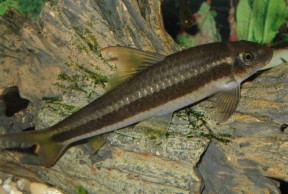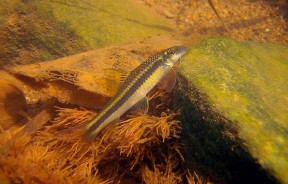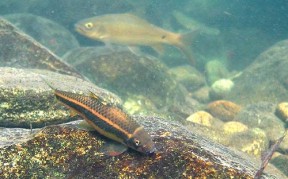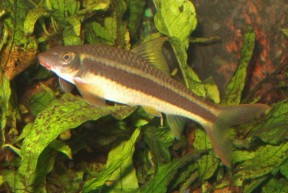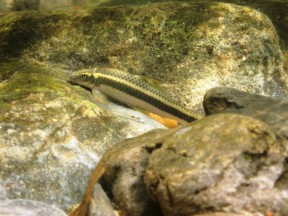Garra cambodgiensis
False SAE
SynonymsTop ↑
Cirrhina cambodgiensis Tirant, 1884; Garra taeniata Smith, 1931; Garra spinosa Fowler, 1934; Garra taeniatops Fowler, 1935; Garra parvifilum Fowler, 1939; ? Discogobio dienbieni Nguyen ,2001
Etymology
Garra: vernacular Gangetic name for a particular species of “sand-digger,” which Francis Buchanan-Hamilton applied as a generic name for bottom-dwelling cyprinids “with no affinity to another genus”.
cambodgiensis: ‘from Cambodia’.
Classification
Order: Cypriniformes Family: Cyprinidae
Distribution
This species is currently considered native to central and lower parts of the Mekong River basin in Thailand, Laos, Cambodia, and Vietnam, the Chao Phraya and Mae Klong drainages in central and westernThailand, and several smaller river systems in peninsular Thailand and northern Peninsular Malaysia.
Type locality is ‘Montagnes de Samrong Tong’. This appears to correspond to the area of the same name in Kamphong Spue province, western Cambodia, which lies within the lower Mekong River basin.
Habitat
Tends to inhabit swiftly-flowing sections of headwaters and tributaries rather than larger, lowland river channels. The most favourable habitats contain clear, oxygen-saturated water which, allied with the sun, facilitates the development of a rich biofilm carpeting submerged surfaces. During periods of high rainfall some streams may be temporarily turbid due to suspended material dislodged by increased (sometimes torrential) flow rate and water depth.
In the Taeng river, a tributary of the Chao Phraya, it was collected in a stream modified by irrigation work alongside Nemacheilus binotatus, Schistura geisleri, S. desmotes, Tuberoschistura baenzigeri, Homalopteroides smithi, H. sexmaculata, Lepidocephalichthys hasselti, Acantopsis sp., Acanthopsoides gracilis, Pangio anguillaris, Systomus orphoides, Mystacoleucus obtusirostris, Opsarius koratensis, Rasbora aurotaenia, Glyptothorax laosensis, G. lampris, Trichopodus trichopterus, Trichopsis vittata and Dermogenys pusillus.
Maximum Standard Length
120 – 150 mm.
Aquarium SizeTop ↑
An aquarium with base measurements of 120 ∗ 45 cm should be the minimum size considered.
Maintenance
Not difficult to keep in a well-maintained set-up, but a display arranged to resemble a flowing stream or river, with a substrate of variably-sized, water-worn rocks, sand, fine gravel and perhaps some small boulders, is highly recommended. This can be further furnished with driftwood roots or branches, and hardy aquatic plants such as Microsorum, Bolbitis, or Anubias spp., which can be grown attached to items of décor.
Most importantly, the water must be clean and well-oxygenated with turnover preferably in excess of 10 times per hour; additional powerheads and airstones can be employed to achieve the desired flow and oxygenation if necessary. Bright lighting will promote development of biofilm on solid surfaces, upon which the fish will graze.
Since it needs stable water conditions and grazes biofilm this species should never be added to a biologically immature set-up, and a tightly-fitting cover is necessary since it can literally climb glass.
Water Conditions
Temperature: 20 – 27 °C
pH: 6.0 – 7.5
Hardness: 18 – 215 ppm
Diet
Although it will graze algae if available this species is not an exclusive herbivore. Offer meaty foods such as live or frozen chironomid larvae (bloodworm), Tubifex, Artemia, chopped prawn, etc., along with good quality, sinking dried products, at least some of which should contain a significant proportion of vegetable matter such as Spirulina or similar.
Fresh fruit and vegetables such as cucumber, melon, blanched spinach or courgette can be offered occasionally and home-made, gelatine-bound recipes containing a mixture of dried fish food, puréed shellfish, fresh fruit and vegetables, are also proven to work well.
Behaviour and CompatibilityTop ↑
Relatively peaceful and makes a good subject for the well-chosen, larger community of stream-dwelling Indochinese species.
It isn’t particularly tolerant of conspecifics but apparently exists in loose aggregations in the wild. If kept singly it tends to behave more aggressively with similarly-shaped fishes so we recommend the purchase of 3-4 or more should space permit. Such a group will develop a noticeable pecking order between themselves but tankmates are more likely to be left alone. What appear to be hierarchical disputes will sometimes occur and involve charging, flaring of fins, an overall paling of the body colouration, and, in males, extension of the rostral process.
Sexual Dimorphism
Sexually mature males develop bright red mouth parts when in spawning condition whereas females are noticeably thicker-bodied fish. Both sexes develop tubercules on the head and snout, but these tend to be more prominent in males.
Reproduction
The results of a study published in 2004 showed that it can be induced to spawn via the use of hormones. Eggs hatched in only 15-16 hours at a temperature of 77-84°F/25-29°C, the fry were initially fed a diet of rotifers and Moina and over 90% of hatched fry survived the first month. We’re unsure whether the approach has been used in the ornamental trade.
NotesTop ↑
Also known by the vernacular names ”Black Band Garra‘, ‘stone-lapping minnow’ or ‘false flying fox’ and continues to be traded as Garra taeniata, an invalid name synonymous with G. cambodgiensis.
It is often confused with those laterally-striped members of the genus Crossocheilus sold as ‘Siamese algae eater’ or ‘Siamese flying fox’, but in those species the dark lateral body stripe continues into the caudal-fin whereas in G. cambodgiensis it terminates at the caudal peduncle and is bordered dorsally by an additional, lighter stripe. The rostral barbels are also more prominent in Crossocheilus, plus they exhibit no patterning in the dorsal fin, nor do they possess the modified lower lip which forms an adhesive ‘sucker’ in all Garra spp. (see below).
Following Rainboth (1996) distinguishing characters for G. cambodgiensis include: presence of rostral barbels; absence of maxillary barbels; possession of 6-10 gill rakers on the first gill arch; ‘cross bands’on the dorsal-fin; a black mid-lateral body stripe; 32-35 lateral line scales; no submarginal stripe in the caudal-fin.
Kottelat (2001) states that the species can be told apart from other Garra occurring in Laos by a combination of two dark bands in the dorsal-fin, a dark mid-lateral stripe with a width of approximately two scale rows, plain caudal-fin with red margins and ‘usually’ tubercules on the snout.
It may still be seen on sale as ‘Siamese algae eater’, possibly because it occurs sympatrically with C. atrilimes, possibly C. langei, and potentially other similarly-patterned Crossocheilus across parts of its range, meaning shipments of wild fish often contain a mixture of two or more of these species.
There also exist a number of comparable Garra spp. of which G. fasciacauda, which also occurs in the Mekong and Chao Phraya drainages but can be told apart by possessing a bright red caudal-fin with black distal bands, is sometimes imported. G. ceylonensis is endemic to Sri Lanka and also available on occasion but the dark body stripe is noticeably more diffuse than in G. cambodgiensis. Other laterally-striped species doubtless exist, but positive identification of some is virtually impossible.
The genus Garra is a particularly enigmatic grouping with new taxa described on a regular basis, while many of the existing ones may represent cases of misidentification or synonyms of other species. Some of the revisions have also been called into question, which has added further confusion. A full generic review would be ideal but is unlikely to materialise given the extensive distribution of its members which range from southern China across much of southeast Asia, India and the Middle East as far as north/central Africa.
Instead a number of less-extensive works published in recent years have resulted in a gradual, but continuing, improvement in knowledge, and it remains possible that the genus will be broken up into smaller taxa since the current assemblage is almost certainly polyphyletic.
Garra species are usually included in the subfamily Labeoninae/Cyprininae or tribe Labeonini (name varies with author) which by recent thinking is further divided into four subtribes; Labeoina, Garraina, Osteochilina, and Semilabeoina (Yang et al., 2012). The putatively monophyletic Garraina comprises a number of genetic lineages including Garra sensu stricto (which also includes Horalabiosa, Phreatichthys and possibly other genera), a small clade comprising Garra cambodgiensis and G. fascicauda (thus rendering Garra polyphyletic), Paracrossocheilus, and Gonorhynchus (which includes Akrokolioplax).
Two Garra species, G. imberba and G. micropulvinus, are placed in the Semilabeoina assemblage, and the generic name Ageneiogarra Garman, 1912 has been suggested for them, although this does not appear to have been widely followed (e.g. Kottelat, 2013). In addition, some genera which were previously considered to be close relatives of Garra species such as Discogobio, Discocheilus and Placocheilus, are now also placed in this subtribe.
All genera currently included in Garraina possess a lower lip modified to form a mental adhesive disc, allowing the fish to cling to surfaces in turbulent conditions. In most species the upper lip is almost entirely reduced and both the upper and lower jaw margins are keratinised, i.e., horny, and used to scrape food items from the substrate.
Garra species are distinguished from other Garraina members by the first two pectoral-fin rays usually being thickened, fleshy and unbranched, possession of 10-11 dorsal-fin rays, and a combination of internal characters. Some species have evolved particular environmental specialisms such as highly reduced eyes in hypogean forms or the ability to survive in thermal springs.
References
- Tirant, G., 1884 - Bulletin de la Société des Etudes Indochinoises 1: 167-173
Note sur quelques espèces de poissons des montagnes de Samrong-Tong (Cambodge). - Kottelat, M., 2013 - Raffles Bulletin of Zoology Supplement 27: 1-663
The fishes of the inland waters of southeast Asia: a catalogue and core bibiography of the fishes known to occur in freshwaters, mangroves and estuaries. - Kottelat, M., 2001 - WHT Publications Ltd., Colombo: 1-198
Fishes of Laos. - Kullander, S. and F. Fang, 2004 - Ichthyological Exploration of Freshwaters 15(3): 257-278
Seven new species of Garra (Cyprinidae: Cyprininae) from the Rakhine Yoma, southern Myanmar. - Pornsopin, P, G. Unsrisong, S. Kantiyawong, A. Müller-Belecke and G. Hörstgen-Schwark, 2004 - Book of Abstracts, ISBN 3-86004-182-7: 399
Induced Spawning and Early Development of Stonelapping Minnow, Garra cambodgiensis (Tirant, 1883). - Rainboth, W. J., 1996 - FAO, Rome: 1-265
Fishes of the Cambodian Mekong. FAO Species Identification Field Guide for Fishery Purposes. - Stiassny, M. L. J. and A. Getahun, 2007 - Zoological Journal of the Linnean Society 150(1): 41-83
An overview of labeonin relationships and the phylogenetic placement of the Afro-Asian genus Garra Hamilton, 1922 (Teleostei: Cyprinidae), with the description of five new species of Garra from Ethiopia, and a key to all African species. - Yang, L., M. Arunachalam, T. Sado, B. A. Levin, A. S. Golubtsov, J. Freyhof, J. P. Friel, W-J. Chen, M. V. Hirt, R. Manickam, M. K. Agnew, A. M. Simons, K. Saitoh, M. Miya, R. L. Mayden, and S. He, 2012 - Molecular Phylogenetics and Evolution 65(2): 362-379
Molecular phylogeny of the cyprinid tribe Labeonini (Teleostei: Cypriniformes). - Zhang, E., 2005 - Zoological Studies 44(1): 130-143
Phylogenetic relationships of labeonine cyprinids of the disc-bearing group (Pisces: Teleostei).
